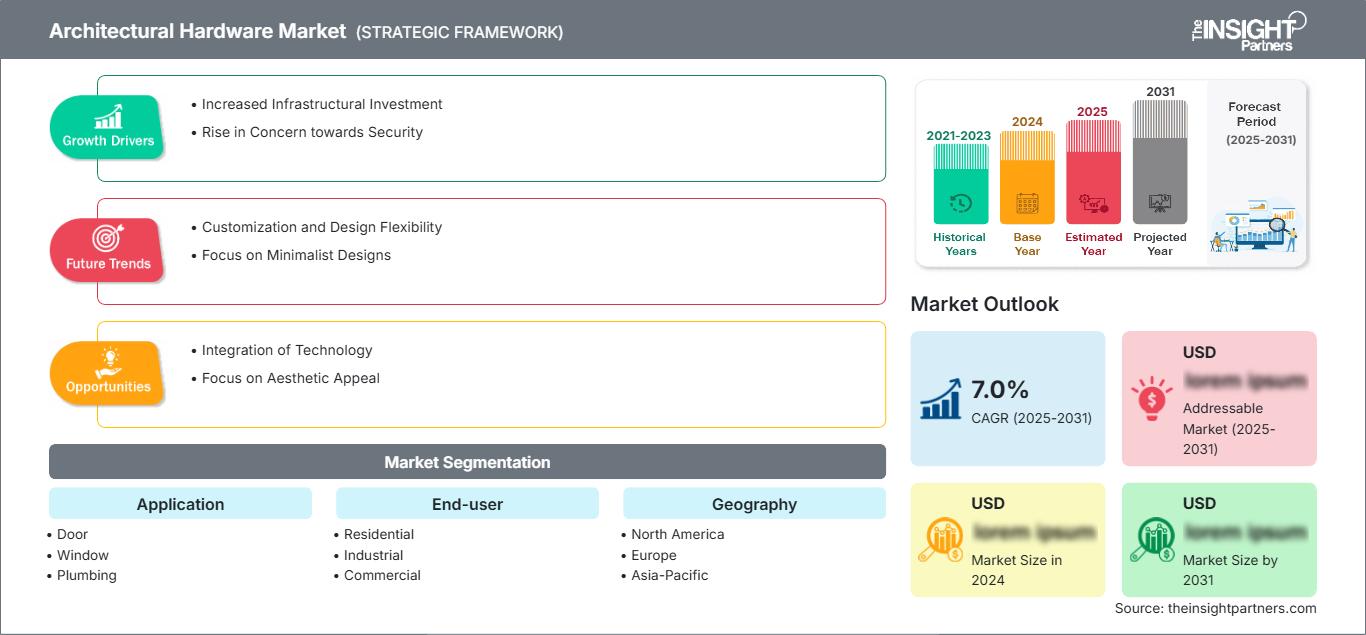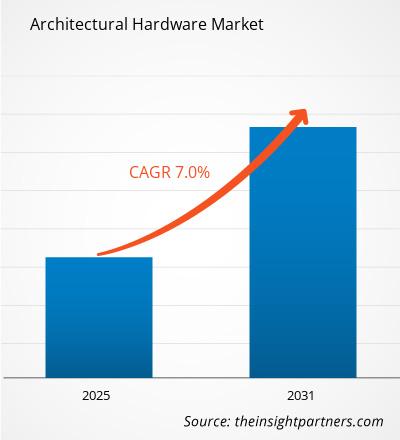Si prevede che il mercato dell'hardware architettonico registrerà un CAGR del 7,0% dal 2025 al 2031, con una dimensione del mercato in espansione da XX milioni di dollari nel 2024 a XX milioni di dollari entro il 2031.
Il rapporto è segmentato per applicazione (porte, finestre, idraulica, arredamento, altri). Il rapporto presenta inoltre un'analisi basata sull'utente finale (residenziale, industriale, commerciale). L'analisi globale è ulteriormente suddivisa a livello regionale e per i principali paesi. Il rapporto offre il valore in USD per l'analisi e i segmenti sopra indicati.
Scopo del rapporto
Il rapporto sul mercato dell'hardware architettonico di The Insight Partners mira a descrivere il panorama attuale e la crescita futura, i principali fattori trainanti, le sfide e le opportunità. Ciò fornirà spunti a vari stakeholder aziendali, come:
- Fornitori/produttori di tecnologia: per comprendere le dinamiche di mercato in evoluzione e conoscere le potenziali opportunità di crescita, consentendo loro di prendere decisioni strategiche informate.
- Investitori: per condurre un'analisi completa delle tendenze in merito al tasso di crescita del mercato, alle proiezioni finanziarie di mercato e alle opportunità esistenti lungo la catena del valore.
- Organismi di regolamentazione: per regolamentare le politiche e le attività di polizia nel mercato con l'obiettivo di ridurre al minimo gli abusi, preservare la fiducia degli investitori e sostenere l'integrità e la stabilità del mercato.
Applicazione della segmentazione del mercato dell'hardware architettonico
- Porte
- Finestre
- Idraulica
- Mobili
- Altri
Utente finale
- Residenziale
- Industriale
- Commerciale
Potrai personalizzare gratuitamente qualsiasi rapporto, comprese parti di questo rapporto, o analisi a livello di paese, pacchetto dati Excel, oltre a usufruire di grandi offerte e sconti per start-up e università
Mercato dell'hardware architettonico: Approfondimenti strategici

-
Ottieni le principali tendenze chiave del mercato di questo rapporto.Questo campione GRATUITO includerà l'analisi dei dati, che vanno dalle tendenze di mercato alle stime e alle previsioni.
Fattori di crescita del mercato dell'hardware architettonico
- Maggiori investimenti infrastrutturali: altri fattori importanti che guidano il mercato dell'hardware architettonico includono maggiori investimenti infrastrutturali. Governi e settore privato stanno effettuando ingenti investimenti in progetti residenziali e non residenziali, aumentando la domanda di una varietà di prodotti hardware architettonici come porte, finestre e accessori per mobili.
- Aumento della preoccupazione per la sicurezza: la crescente preoccupazione per la sicurezza e la praticità all'interno degli edifici ha portato a una maggiore domanda di soluzioni hardware architettoniche più sofisticate, come serrature intelligenti e sistemi automatizzati. Ciò indica la preferenza comune dei consumatori verso prodotti tecnologicamente avanzati per migliorare la sicurezza e la fruibilità nei progetti architettonici.
Tendenze future del mercato dell'hardware architettonico
- Personalizzazione e flessibilità di progettazione: la personalizzazione e la customizzazione sono tendenze attuali nelle soluzioni architettoniche che offrono ai produttori l'opportunità di soddisfare le richieste dei consumatori in base alle loro specifiche esigenze. Molte opzioni hardware personalizzabili migliorano la soddisfazione del cliente e offrono un vantaggio competitivo ai marchi in questo mercato altamente competitivo.
- Focus sul design minimalista: l'enfasi sul design minimalista e contemporaneo in architettura sta plasmando le tendenze nel mercato dell'hardware architettonico. Soluzioni hardware eleganti e discrete che si integrano con l'estetica moderna sono sempre più richieste, influenzando lo sviluppo dei prodotti.
Opportunità di mercato per l'hardware architettonico
- Integrazione della tecnologia: l'integrazione della tecnologia nei prodotti è di tendenza nel mercato dell'hardware architettonico. Esiste un'applicazione di tecnologie intelligenti utilizzate in serrature e sistemi di accesso, oltre a materiali avanzati utilizzati per aggiungere durata e funzionalità.
- Focus sull'aspetto estetico: progettare l'hardware architettonico in base all'aspetto estetico, oltre che alla funzionalità, è diventato una preoccupazione in continua evoluzione. I consumatori richiedono più hardware che si adattino allo stile architettonico moderno, cambiando così design e finiture.
Mercato dell'hardware architettonico
Le tendenze regionali e i fattori che influenzano il mercato dell'hardware architettonico durante il periodo di previsione sono stati ampiamente spiegati dagli analisti di The Insight Partners. Questa sezione illustra anche i segmenti e la geografia del mercato dell'hardware architettonico in Nord America, Europa, Asia-Pacifico, Medio Oriente e Africa, America meridionale e centrale.
Ambito del rapporto sul mercato dell'hardware architettonico
| Attributo del rapporto | Dettagli |
|---|---|
| Dimensioni del mercato in 2024 | US$ XX million |
| Dimensioni del mercato per 2031 | US$ XX Million |
| CAGR globale (2025 - 2031) | 7.0% |
| Dati storici | 2021-2023 |
| Periodo di previsione | 2025-2031 |
| Segmenti coperti |
By Applicazione
|
| Regioni e paesi coperti |
Nord America
|
| Leader di mercato e profili aziendali chiave |
|
Densità degli operatori del mercato dell'hardware architettonico: comprendere il suo impatto sulle dinamiche aziendali
Il mercato dell'hardware architettonico è in rapida crescita, trainato dalla crescente domanda degli utenti finali dovuta a fattori quali l'evoluzione delle preferenze dei consumatori, i progressi tecnologici e una maggiore consapevolezza dei vantaggi del prodotto. Con l'aumento della domanda, le aziende stanno ampliando la propria offerta, innovando per soddisfare le esigenze dei consumatori e sfruttando le tendenze emergenti, alimentando ulteriormente la crescita del mercato.

- Ottieni il Mercato dell'hardware architettonico Panoramica dei principali attori chiave
Punti di forza
- Copertura completa: il rapporto analizza in modo esaustivo prodotti, servizi, tipologie e utenti finali del mercato dell'hardware architettonico, offrendo una panoramica olistica.
- Analisi degli esperti: il rapporto è redatto sulla base della conoscenza approfondita di esperti e analisti del settore.
- Informazioni aggiornate: il rapporto garantisce la pertinenza aziendale grazie alla copertura di informazioni e tendenze dei dati recenti.
- Opzioni di personalizzazione: questo rapporto può essere personalizzato per soddisfare le esigenze specifiche del cliente e adattarsi in modo appropriato alle strategie aziendali.
Il rapporto di ricerca sul mercato dell'hardware architettonico può quindi contribuire a guidare il percorso di decodificazione e comprensione dello scenario del settore e delle prospettive di crescita. Sebbene possano esserci alcune valide preoccupazioni, i vantaggi complessivi di questo rapporto tendono a superare gli svantaggi.
- Analisi storica (2 anni), anno base, previsione (7 anni) con CAGR
- Analisi PEST e SWOT
- Valore/volume delle dimensioni del mercato - Globale, Regionale, Nazionale
- Industria e panorama competitivo
- Set di dati Excel
Report recenti
Testimonianze
Motivo dell'acquisto
- Processo decisionale informato
- Comprensione delle dinamiche di mercato
- Analisi competitiva
- Analisi dei clienti
- Previsioni di mercato
- Mitigazione del rischio
- Pianificazione strategica
- Giustificazione degli investimenti
- Identificazione dei mercati emergenti
- Miglioramento delle strategie di marketing
- Aumento dell'efficienza operativa
- Allineamento alle tendenze normative






















 Ottieni un campione gratuito per - Mercato dell'hardware architettonico
Ottieni un campione gratuito per - Mercato dell'hardware architettonico